5.1.5: Wheat in Pasta
- Page ID
- 64510
\( \newcommand{\vecs}[1]{\overset { \scriptstyle \rightharpoonup} {\mathbf{#1}} } \)
\( \newcommand{\vecd}[1]{\overset{-\!-\!\rightharpoonup}{\vphantom{a}\smash {#1}}} \)
\( \newcommand{\id}{\mathrm{id}}\) \( \newcommand{\Span}{\mathrm{span}}\)
( \newcommand{\kernel}{\mathrm{null}\,}\) \( \newcommand{\range}{\mathrm{range}\,}\)
\( \newcommand{\RealPart}{\mathrm{Re}}\) \( \newcommand{\ImaginaryPart}{\mathrm{Im}}\)
\( \newcommand{\Argument}{\mathrm{Arg}}\) \( \newcommand{\norm}[1]{\| #1 \|}\)
\( \newcommand{\inner}[2]{\langle #1, #2 \rangle}\)
\( \newcommand{\Span}{\mathrm{span}}\)
\( \newcommand{\id}{\mathrm{id}}\)
\( \newcommand{\Span}{\mathrm{span}}\)
\( \newcommand{\kernel}{\mathrm{null}\,}\)
\( \newcommand{\range}{\mathrm{range}\,}\)
\( \newcommand{\RealPart}{\mathrm{Re}}\)
\( \newcommand{\ImaginaryPart}{\mathrm{Im}}\)
\( \newcommand{\Argument}{\mathrm{Arg}}\)
\( \newcommand{\norm}[1]{\| #1 \|}\)
\( \newcommand{\inner}[2]{\langle #1, #2 \rangle}\)
\( \newcommand{\Span}{\mathrm{span}}\) \( \newcommand{\AA}{\unicode[.8,0]{x212B}}\)
\( \newcommand{\vectorA}[1]{\vec{#1}} % arrow\)
\( \newcommand{\vectorAt}[1]{\vec{\text{#1}}} % arrow\)
\( \newcommand{\vectorB}[1]{\overset { \scriptstyle \rightharpoonup} {\mathbf{#1}} } \)
\( \newcommand{\vectorC}[1]{\textbf{#1}} \)
\( \newcommand{\vectorD}[1]{\overrightarrow{#1}} \)
\( \newcommand{\vectorDt}[1]{\overrightarrow{\text{#1}}} \)
\( \newcommand{\vectE}[1]{\overset{-\!-\!\rightharpoonup}{\vphantom{a}\smash{\mathbf {#1}}}} \)
\( \newcommand{\vecs}[1]{\overset { \scriptstyle \rightharpoonup} {\mathbf{#1}} } \)
\( \newcommand{\vecd}[1]{\overset{-\!-\!\rightharpoonup}{\vphantom{a}\smash {#1}}} \)
\(\newcommand{\avec}{\mathbf a}\) \(\newcommand{\bvec}{\mathbf b}\) \(\newcommand{\cvec}{\mathbf c}\) \(\newcommand{\dvec}{\mathbf d}\) \(\newcommand{\dtil}{\widetilde{\mathbf d}}\) \(\newcommand{\evec}{\mathbf e}\) \(\newcommand{\fvec}{\mathbf f}\) \(\newcommand{\nvec}{\mathbf n}\) \(\newcommand{\pvec}{\mathbf p}\) \(\newcommand{\qvec}{\mathbf q}\) \(\newcommand{\svec}{\mathbf s}\) \(\newcommand{\tvec}{\mathbf t}\) \(\newcommand{\uvec}{\mathbf u}\) \(\newcommand{\vvec}{\mathbf v}\) \(\newcommand{\wvec}{\mathbf w}\) \(\newcommand{\xvec}{\mathbf x}\) \(\newcommand{\yvec}{\mathbf y}\) \(\newcommand{\zvec}{\mathbf z}\) \(\newcommand{\rvec}{\mathbf r}\) \(\newcommand{\mvec}{\mathbf m}\) \(\newcommand{\zerovec}{\mathbf 0}\) \(\newcommand{\onevec}{\mathbf 1}\) \(\newcommand{\real}{\mathbb R}\) \(\newcommand{\twovec}[2]{\left[\begin{array}{r}#1 \\ #2 \end{array}\right]}\) \(\newcommand{\ctwovec}[2]{\left[\begin{array}{c}#1 \\ #2 \end{array}\right]}\) \(\newcommand{\threevec}[3]{\left[\begin{array}{r}#1 \\ #2 \\ #3 \end{array}\right]}\) \(\newcommand{\cthreevec}[3]{\left[\begin{array}{c}#1 \\ #2 \\ #3 \end{array}\right]}\) \(\newcommand{\fourvec}[4]{\left[\begin{array}{r}#1 \\ #2 \\ #3 \\ #4 \end{array}\right]}\) \(\newcommand{\cfourvec}[4]{\left[\begin{array}{c}#1 \\ #2 \\ #3 \\ #4 \end{array}\right]}\) \(\newcommand{\fivevec}[5]{\left[\begin{array}{r}#1 \\ #2 \\ #3 \\ #4 \\ #5 \\ \end{array}\right]}\) \(\newcommand{\cfivevec}[5]{\left[\begin{array}{c}#1 \\ #2 \\ #3 \\ #4 \\ #5 \\ \end{array}\right]}\) \(\newcommand{\mattwo}[4]{\left[\begin{array}{rr}#1 \amp #2 \\ #3 \amp #4 \\ \end{array}\right]}\) \(\newcommand{\laspan}[1]{\text{Span}\{#1\}}\) \(\newcommand{\bcal}{\cal B}\) \(\newcommand{\ccal}{\cal C}\) \(\newcommand{\scal}{\cal S}\) \(\newcommand{\wcal}{\cal W}\) \(\newcommand{\ecal}{\cal E}\) \(\newcommand{\coords}[2]{\left\{#1\right\}_{#2}}\) \(\newcommand{\gray}[1]{\color{gray}{#1}}\) \(\newcommand{\lgray}[1]{\color{lightgray}{#1}}\) \(\newcommand{\rank}{\operatorname{rank}}\) \(\newcommand{\row}{\text{Row}}\) \(\newcommand{\col}{\text{Col}}\) \(\renewcommand{\row}{\text{Row}}\) \(\newcommand{\nul}{\text{Nul}}\) \(\newcommand{\var}{\text{Var}}\) \(\newcommand{\corr}{\text{corr}}\) \(\newcommand{\len}[1]{\left|#1\right|}\) \(\newcommand{\bbar}{\overline{\bvec}}\) \(\newcommand{\bhat}{\widehat{\bvec}}\) \(\newcommand{\bperp}{\bvec^\perp}\) \(\newcommand{\xhat}{\widehat{\xvec}}\) \(\newcommand{\vhat}{\widehat{\vvec}}\) \(\newcommand{\uhat}{\widehat{\uvec}}\) \(\newcommand{\what}{\widehat{\wvec}}\) \(\newcommand{\Sighat}{\widehat{\Sigma}}\) \(\newcommand{\lt}{<}\) \(\newcommand{\gt}{>}\) \(\newcommand{\amp}{&}\) \(\definecolor{fillinmathshade}{gray}{0.9}\)Pasta is made from an unleavened dough of wheat flour mixed with a liquid. The liquid is usually egg and/or water. The flour can be from almost any grain: wheat, buckwheat, rice or a combination of grains. The dough can be colored and flavored with pureed vegetables, herbs, or other ingredients, and it can be cut or extruded into a wide variety of shapes and sizes.
Pasta can be cooked fresh while the dough is still moist and pliable, or the dough can be allowed to dry completely before cooking. Pasta can be filled or sauced in an endless variety of ways. It can stand alone, or be used in salads, desserts, soups, or casseroles.
Pasta is widely used in the cuisines of Asia, North America and Europe. In Italy, pasta dishes are usually served as a separate course, often referred to as the minestre; in other European countries, Asia, and the United States, pasta dishes may be served as an appetizer, entree, or side dish.
Identifying Pastas
The better-known pastas are based on the Italian tradition of kneading wheat flour with water and eggs to form a smooth, resilient dough. This dough is then rolled very thin, and cut into various shapes before boiling in water, or dried for longer storage.
Commercially prepared dried pasta products are usually made with semolina flour. Semolina flour, ground from hard durum wheat and available from specialty purveyors, has a rich cream color and produces a very smooth, durable dough. Semolina dough requires a great deal of kneading, however, bread flour is an acceptable substitute when preparing fresh pasta by hand.
Asian pasta, generally known as noodles, is made from wheat, rice, bean, or buckwheat flour. It is available fresh or dried from commercial purveyors and at specialty markets.
Italian-Style Pasta
Although all Italian-style pasta is made from the same type of dough, the finest commercial pastas are those made with pure semolina flour, which gives the dough a rich, yellow color. Gray or streaked dough probably contains softer flours. Dried pasta should be very hard and break with a clean snap. The surface should be lightly pitted or dull. (A smooth or glossy surface will not hold or absorb sauces as well.)
Dried pasta, both domestic and imported, is available in a wide range of flavors and shapes. In addition to the traditional white ( plain ), green (spinach) and red (tomato) pastas, manufacturers are now offering flavor combinations such as lemon-peppercorn, whole wheat-basil and carrot-ginger. Small pieces of herbs or other flavorings are often visible in these products.
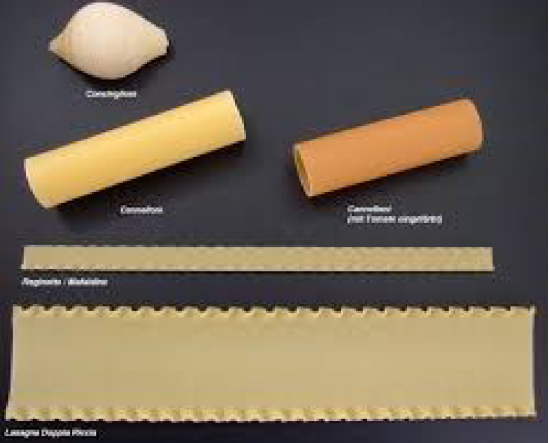
There are hundreds of recognized shapes of pasta, but only two or three dozen are generally available in the United States. When experimenting with unusual flavors and shapes, be sure to consider the taste and appearance of the final dish after the sauce and any garnishes are added.
Italian-style pasta can be divided into three groups based on the shape of the final product: ribbons, tubes, and shapes. There is no consistent English nomenclature for these pastas; the Italian names are recognized and applied virtually worldwide. (A specific shape or size may be given different names in different regions of Italy, however. These distinctions are beyond the scope of this text.)
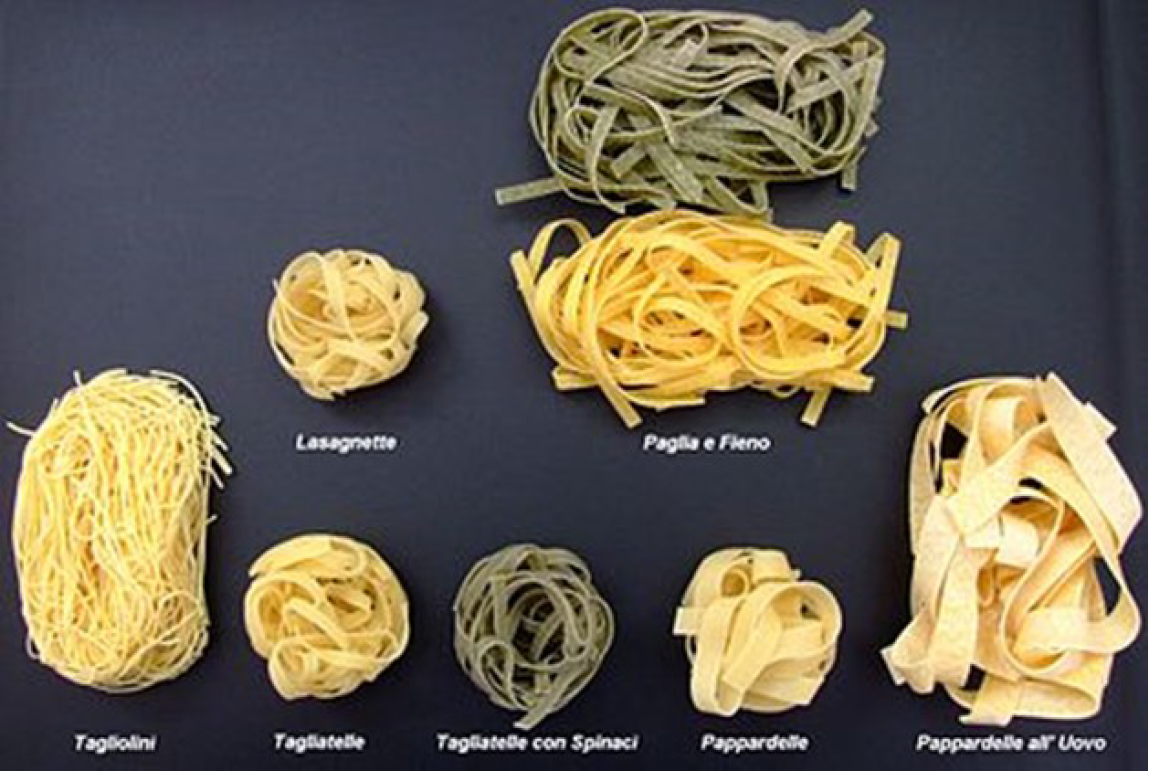
Ribbons
Pasta dough can be rolled very thin and cut into strips, or ribbons, of various widths. All ribbon shapes work well with tomato, fish, and shellfish sauces. Thicker ribbons, such as spaghetti and fettuccine, are preferred with cream or cheese sauces. Sheets of fresh pasta dough can be filled and shaped to create ravioli, cappelletti, and tortellini. Filled pasta is usually served with a light creamer tomato-based sauce that complements the filling's flavors.
Tubes
Cylindrical forms or tubes are made by extrusion. The hollow tubes can be curved or straight, fluted or smooth. Tubes are preferred for meat and vegetable sauces and are often used in baked casseroles.
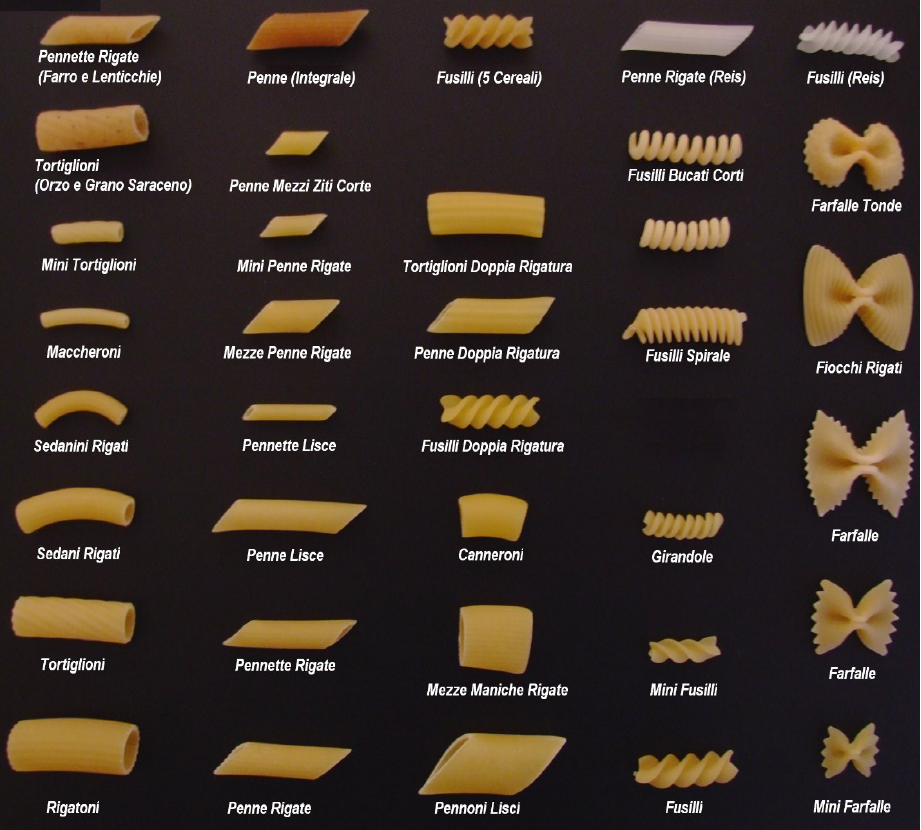
Shapes - Additional Ribbons
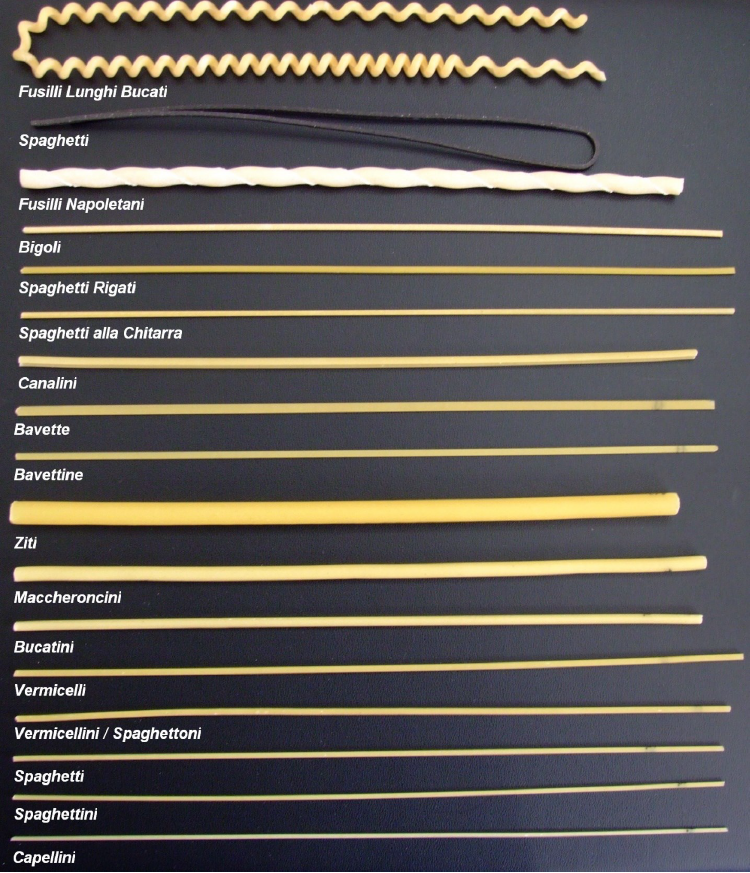
The extrusion process can also be used to shape pasta dough into forms. The curves and textures produced provide nooks and crevices that hold sauces well. Shaped pastas, such as conchiglie, farfalle and fusilli, are preferred with meat sauces and oil-based sauces such as pesto. Larger-shaped pastas can be cooked, then stuffed with meat or cheese fillings and baked or served as a casserole.
Gnocchi
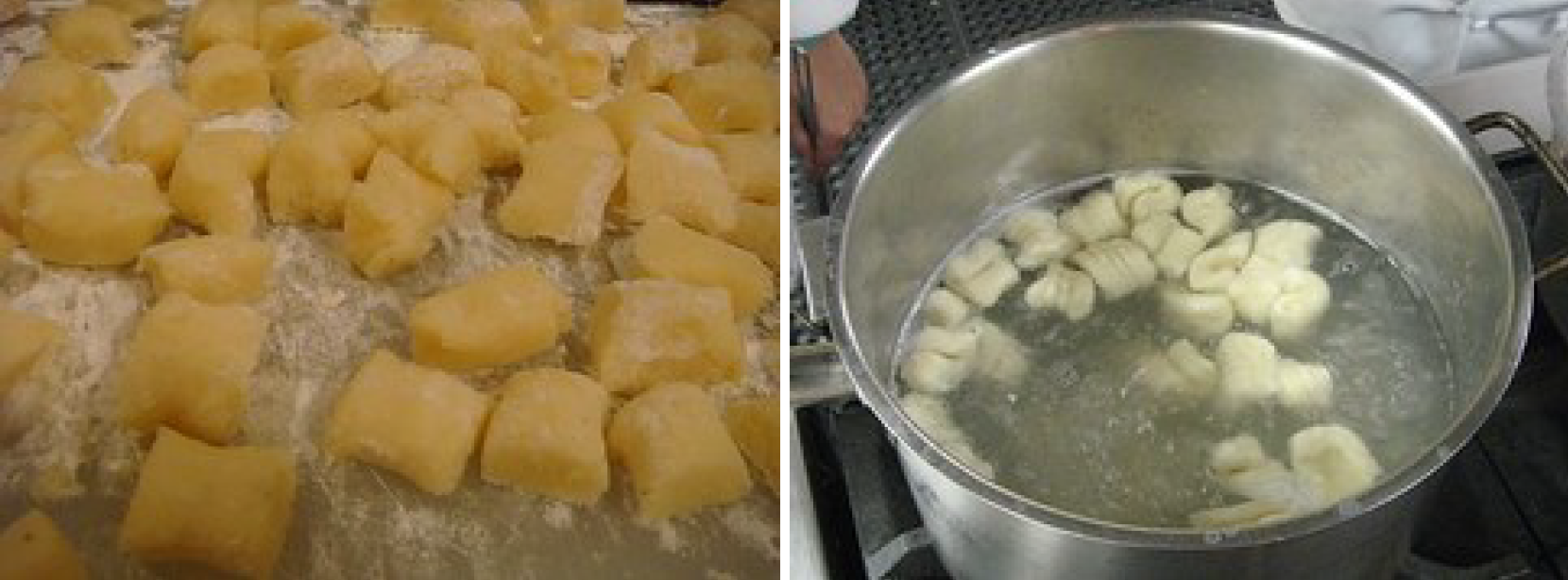
Spaetzle

Cooked Spaetzle Batter passes through device
Asian Noodles
Asian noodles are not cut into the same wealth of shapes and sizes as Italian-style pasta, nor are they flavored or colored with vegetable purees, herbs or other ingredients.
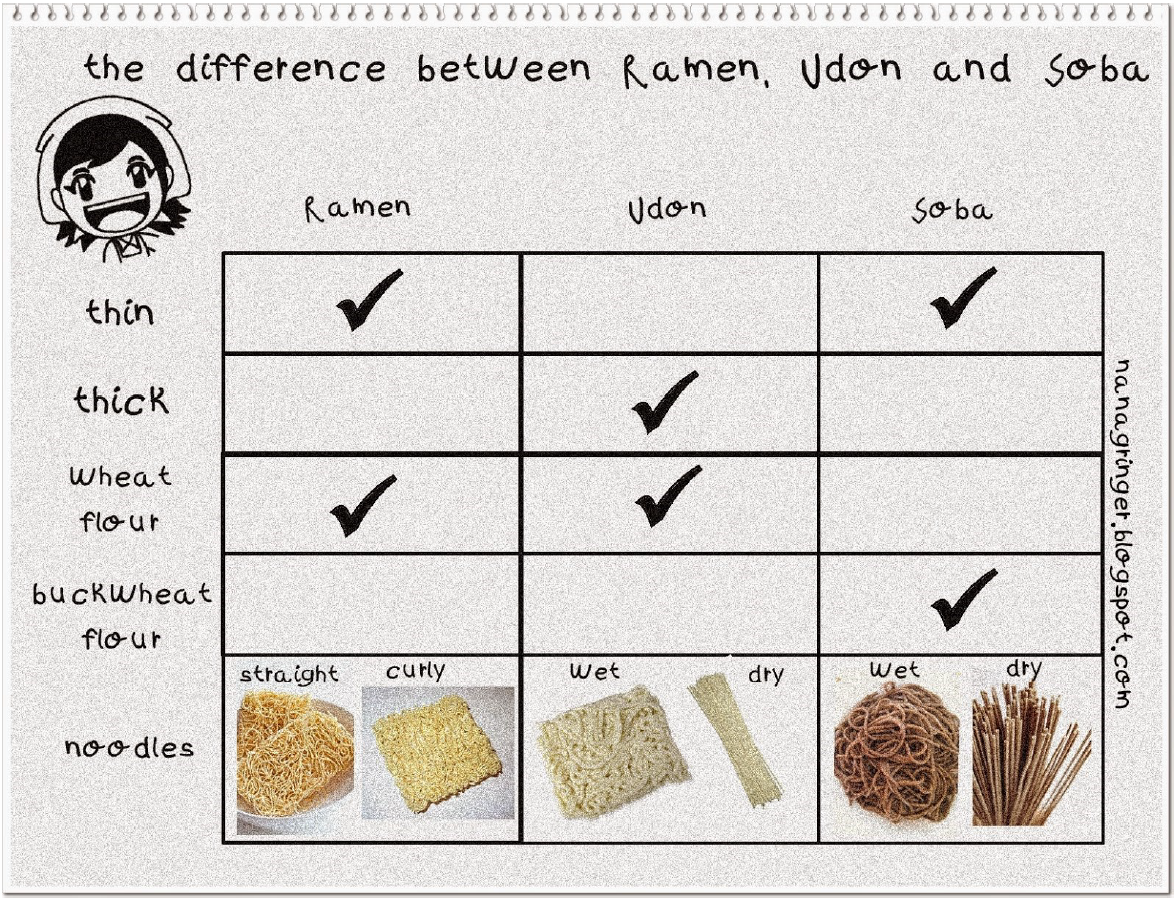
Virtually all Asian noodles are ribbons some thin, some thick-folded into bundles and packaged. Differences arise because of the flour used for the dough. Most dried Asian noodles benefit from soaking in hot water for several minutes before further preparation. The water softens the noodle strands; the bundles separate and the noodles cook more evenly.
Wheat Noodles
Wheat noodles, also known as egg noodles, are the most popular and most widely available of the Asian noodles. They are thin, flat noodles with a springy texture; they are available fresh or dried. Dried egg noodles can be deep-fried after boiling to create crisp golden noodles (chow mein) used primarily as a garnish. Japanese wheat noodles, known as somen (if thin) and udon (if thick), may be round, square or flat. They are eaten in broth or with a dipping sauce.
Rice Noodles
Rice noodles are thin dried noodles made with rice flour. They should be soaked in hot water before cooking and rinsed in cool running water after boiling to remove excess starch and prevent sticking. Rice noodles are often served in soups or sautéed.
Rice vermicelli, which has very fine strands, can be fried in hot oil without presoaking. In only a few seconds, the strands will turn white, puff up and become crunchy. Mounds of crunchy rice noodles can be used as a base for sautéed dishes or for presenting hors d'oeuvre.
Bean Starch Noodles
Bean starch noodles are also known as spring rain noodles, bean threads, bean noodles or cellophane noodles. They are thin, transparent noodles made from mung beans. Dried bean noodles can be fried in the same manner as rice vermicelli. Otherwise, they must be soaked in hot water before using in soups, stir-fries or braised dishes.
Buckwheat Noodles
Buckwheat flour is used in the noodles of northern Japan and the Tokyo region, known as soba noodles. Soba noodles are available fresh or dried and do not need soaking before cooking. They are traditionally served in broth or with a dipping sauce, but may be substituted for Italian-style pasta if desired.
Dumplings
A dumpling is a small mound of dough cooked by steaming or simmering in a flavorful liquid. Dumplings are found in many cuisines: Italian gnocchi, Jewish matzo balls, German spaetzle, Chinese wontons, Belorussian pelmeni and Polish pierogi Dumplings can be sweet or savory, plain or filled.
Plain or drop dumplings are made with a bread-like dough, often leavened with yeast or chemical leavening agents. They should be light and tender, but firm enough to hold their shape when cooked. Drop dumplings may be served with stews or broths, or coated with butter or sauce as an appetizer or side dish. Filled dumplings are made by wrapping noodle dough around seasoned meat, vegetables, cheese or fruit. These parcels are then steamed, fried or baked and served as a snack food, appetizer or side dish.
Nutrition
Pastas are very low in fat and are an excellent source of vitamins, minerals, proteins and carbohydrates. In addition, the processed products are sometimes enriched with additional nutrients.
Purchasing and Storing Pasta Products
Pasta products are purchased by weight, either fresh or dried. Tubes and shapes are not generally available fresh. Dried products, by far the most common, are available in boxes or bags, usually in 1-, 10- and 20-pound units. They can be stored in a cool, dry place for several months. Fresh pasta can be stored in an airtight wrapping in the refrigerator for a few clays or in the freezer for a few weeks.
Preparing Fresh Pasta
Making Fresh Pasta
Fresh pasta is easy to make, requiring almost no special equipment and only a few staples. The basic form is the sfoglia, a thin, flat sheet of dough that is cut into ribbons, circles or squares.
Although pasta dough can be kneaded by hand, stretched and rolled with a rolling pin and cut with a chef's knife, pasta machines make these tasks easier. Pasta machines are either electric or manual. So me electric models mix and knead the dough, then extrude it through a cutting disk. An extrusion machine is most practical in a food service operation that regularly serves large quantities of pasta. The pasta machine more often encountered is operated manually with a hand crank. It has two rollers that knead, press and push the dough into a thin, uniform sheet. Adjacent cutting rollers slice the thin dough into various widths for fettuccine, spaghetti, capellini and the like.
Filling Pasta
Sheets of raw pasta dough can be filled or folded to create ravioli (squares), tortellini (round "hats" with a brim of dough), lunettes (circles of dough folded into half-moons), agnolotti (squares of dough folded into rectangles), cappelletti (squares of dough folded and shaped into rings) and other shapes. The filled pieces of dough are then cooked in boiling water using the procedure for cooking pasta ribbons discussed later. The filling can include almost anything cheese, herbs, vegetables, fish, shellfish, meat or poultry. It can be uncooked or precooked. Nevertheless, any meat filling should be fully cooked before the pasta is assembled, as the time it takes for the dough to cook may not be sufficient to cook the filling.
Cannelloni is a different type of filled pasta: A large square of cooked dough is wrapped around a meat or cheese filling and baked. Popular lasagna dishes are similar. Lasagna are wide, flat sheets of pasta that are cooked and then layered with cheese, tomato sauce and meat or vegetables as desired. The finished casserole is baked and cut into portions.
Some of the larger, commercially prepared pasta shapes such as large shells (conchigloni or rigate) or large tubes (manicotti) can be partially cooked in boiling water, then filled, sauced and baked as a casserole.
Asian noodle dough is also made into filled items such as dumplings, wontons, egg rolls (made with egg noodle dough) and spring rolls (made with rice paper). These items are usually steamed, pan-fried or deep-fried. When making filled pasta, consider the flavors and textures of the filling, dough and sauce. Each should complement the others.
Cooking Method
Determining Doneness
Italian - style pastas are properly cooked when they are al dente, firm but tender. Cooking times vary depending on the shape and quantity of pasta, the amount of water used ,the hardness of the water, and even the altitude. Fresh pasta cooks rapidly, sometimes in seconds. Noodles and dried pasta may require several minutes.
Although package or recipe directions offer some guidance, the only way to accurately test done-ness is to bite into a piece. When the pasta is slightly firmer than desired, remove it from the stove and drain. It will continue to cook through residual heat.
Unlike Italian pasta, Asian noodles are not served al dente. Rather, they are either boiled until very soft or stir-fried until very crisp.
Boiling
All Italian-style pasta and most Asian noodles are cooked by just one method: boiling. The secret to boiling pasta successfully is to use ample water. Allow 1 gallon (4 liters) of water for each pound (450 grams) of pasta.
Use a saucepan or stockpot large enough to allow the pasta to move freely in the boiling water; otherwise, the starch released by the dough will make the pasta gummy and sticky. The water should be brought to a rapid boil, then all the pasta should be added at once.
Salt should be added to the water. Pasta absorbs water and salt during cooking. Adding salt to the pasta after it is cooked will not provide the same seasoning effect.
Chefs disagree on whether to add oil to the cooking water. Purists argue against adding oil, on the theory that it makes the dough absorb water unevenly. Others think oil should be added to reduce surface foam. Another theory is that oil keeps the pasta from sticking, although this works only when added to cooked, drained pasta.
Asian noodles may be prepared by boiling until fully cooked, or they may be parboiled and then stir-fried with other ingredients to finish cooking.
- cracking a milling process in which grains are broken open
- grinding a milling process in which grains are reduced to a powder; the powder can be of differing degrees of fineness or coarseness
- hulling a milling process in which the hull or husk is removed from grains
- pearling a milling process in which all or part of the hull, bran and germ are removed from grains
- extrusion the process of forcing pasta dough through perforated plates to create various shapes; pasta dough that is not extruded must be rolled and cut
- macaroni any dried pasta made with wheat flour and water; only in the United States does the term refer to elbow-shaped tubes
- al dente Italian for "to the tooth"; used to describe a food, usually pasta, that is cooked only until it gives a slight resistance when one bites into it.


